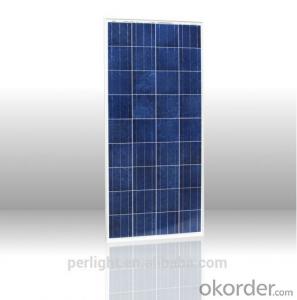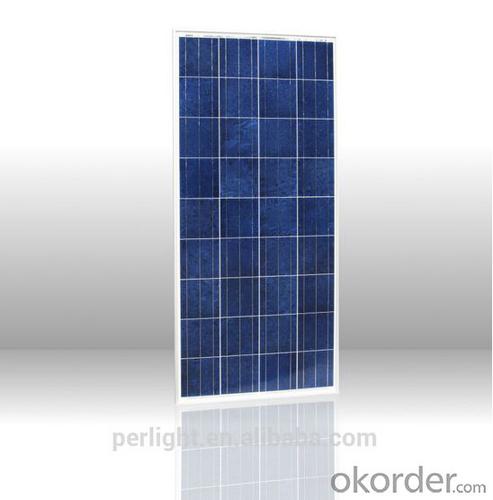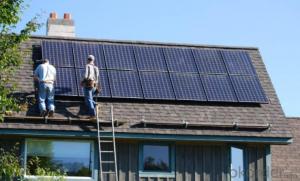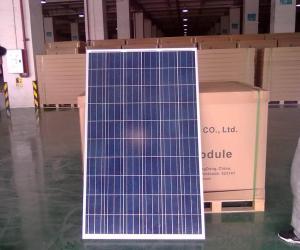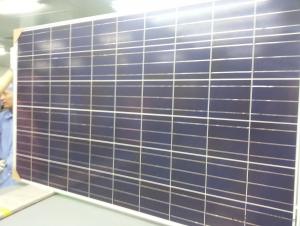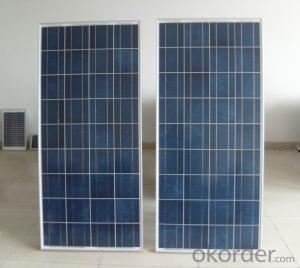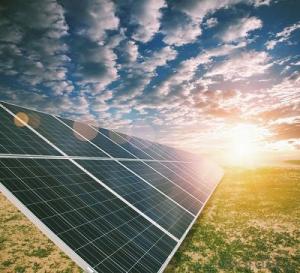Best Motorhome Solar Panels - CE and TUV Approved 80W Poly Solar Panel
- Loading Port:
- Shanghai
- Payment Terms:
- TT OR LC
- Min Order Qty:
- 10000 watt
- Supply Capability:
- 20000000 watt/month
OKorder Service Pledge
OKorder Financial Service
You Might Also Like
Specification
1. The Introduction of Solar Module
Solar modules use light energy from the sun to generate electricity through the photovoltaic effect. The majority of modules use wafer-based crystalline silicon cells or thin-film cells based on cadmium telluride or silicon. The structural (load carrying) member of a module can either be the top layer or the back layer. Cells must also be protected from mechanical damage and moisture. Most solar modules are rigid, but semi-flexible ones are available, based on thin-film cells.
2.Technical Parameter
Type | CNBM Solar Polycrystalline Series |
Materials | Silicon |
Guarantee | 12 yrs free from defects in materials and workmanship No less than 90% within 10yrs and no less than 80% within 25yrs TUV(IEC61215&IEC61730), CE, UL |
Application | Photovoltaic/ solar/ green energy/ energy saving |
Descriptions | 1.High efficiency crystalline silicon solar cell. Even if under the weak light, the solar module can produce maximum power output. 2.Tempered glass (toughened glass): Anti-reflecting coating and high transmission rate glass increase the power output and mechanical strength of solar module. 3. EVA and TPT: Using high quality EVA and TPT to prevent destroying and water. 4. AI frame: Without screw, rner connection. 6 holes on the frame can be installed easily. 5. Junction box: Multi function junction box with water proof. 6. Long lifetime: ≥25 years; Less power decrease. 7. Good performance of preventing from atrocious weather such as wind and hails. 8. Resisting moisture and etching effectively, not effected by geology. 9. The certificate issued by international authority: UL, TUV, IEC, CE.
|
Packaging Details: | 26pcs/pallet, 28pallets/ 40HQ Our solar panels are packed in cartons, and then pallet. Shipping by sea or by air are both ok, it up to customer’s chose. We’d like to inquiry the freight cost for customer after be informed exact quantity and destination address. |
3. Application and Pictures of Products
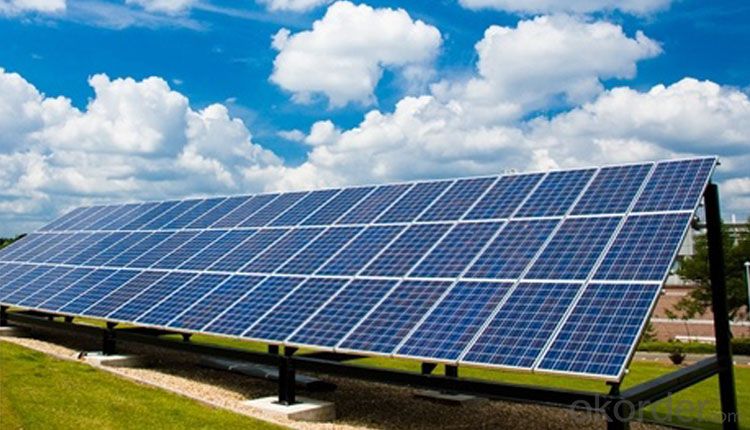
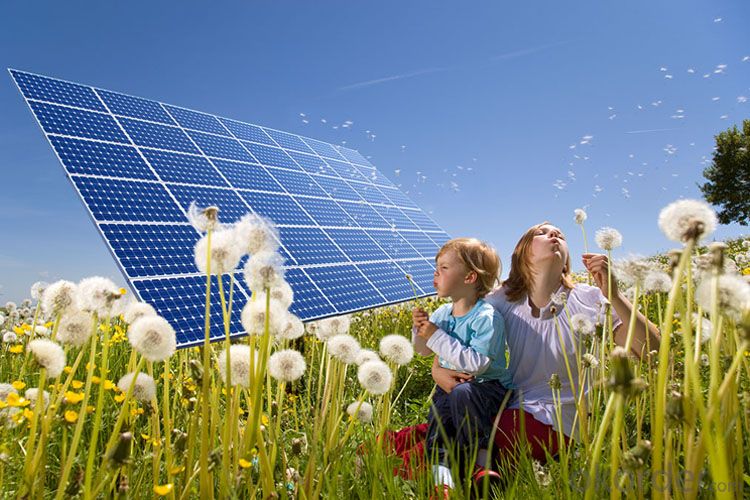
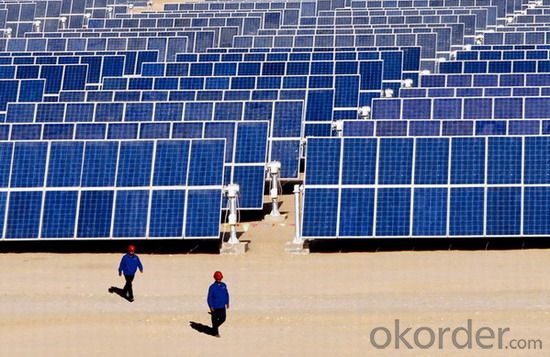
4. How to Work

5. Packing Details
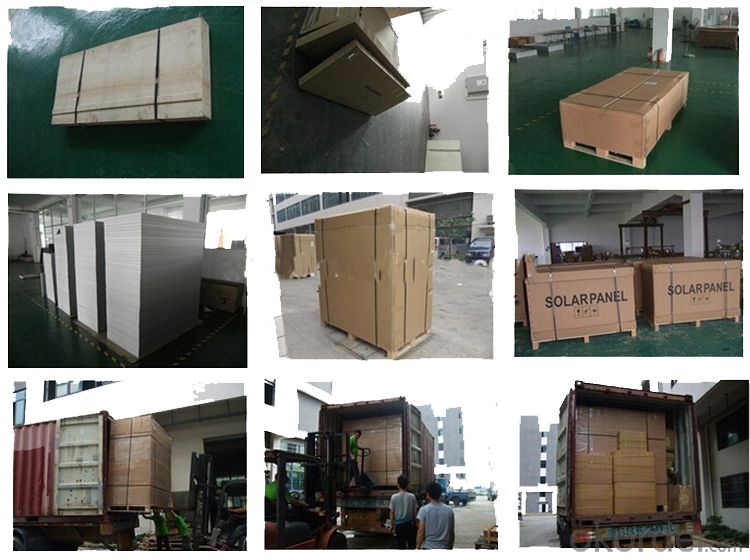
6. FAQ
Q1: What is the business type for the company?
A1: We are one of the biggest manufacturers in zhejiang.Chnia. Which is a high tech PV enterprise dedicated to the research, development, production and sales..
Q2: How long solar panel warranty can you offer?
A2: 10-Year product warranty,25-year linear power output warranty
If there is any quality problem, we will pay for freight and send free parts to you.
Q3: How many certificates do you have?
A3: We have 16 certificates,such as CE, TUV, UL, and so on.
- Q: this solar panel i saw was for 500 dollars(i get a 25% discount)and i was curious will they produce electricity? or just heat?what do they do?is it a good investment?here is a link to the one i would like, no reviews but it looks new to the site.
- This is a photovoltaic panel...it produces electricity from incident solar radiation. Solar thermal panels produce heat, and they are usually assists for hot water heating systems. Solar thermal panels have piping in them instead of semiconductor cells like photovoltaics do.
- Q: Can solar panels be installed on residential complexes or apartment buildings?
- Yes, solar panels can be installed on residential complexes or apartment buildings. Many residential complexes and apartment buildings have successfully installed solar panels to generate clean and renewable energy for their residents. This not only helps in reducing electricity bills but also contributes to a greener and more sustainable environment.
- Q: Can solar panels be used in areas with high levels of air pollution?
- Yes, solar panels can be used in areas with high levels of air pollution. Although air pollution can reduce the efficiency of solar panels by blocking sunlight, advancements in technology have made solar panels more resilient to such conditions. Moreover, regular cleaning and maintenance can help mitigate the impact of air pollution on solar panels.
- Q: Which kit did you use?How easy was it to build? How much did it cost to build the panels?How many kw or watts does it produce?Any other info on the kit or panels you built would be helpful.Thanks!
- sure, but if you don't know what you are doing you could really hurt or kill yourself. Basically you can do whatever you want on your side of the power meter and in the rare occurrence when your solar panels are producing more power that your home is using the meter will run backwards and you will be feeding power to the grid and theoretically reducing your power bill. At the very least you will be using less power from the grid
- Q: How do solar panels affect roof ventilation?
- Solar panels can have both positive and negative effects on roof ventilation. On one hand, solar panels can provide shade to the roof, reducing heat gain and potentially improving the overall ventilation of the roof space. On the other hand, solar panels can obstruct airflow and create a barrier that hinders natural ventilation. Proper installation and design considerations are crucial to ensure that solar panels do not negatively impact roof ventilation.
- Q: How efficient are solar panels when it comes to turning light into energy? If it's not 00%, why? Can it be improved? Also, how do solar panels work, exactly.
- Solar okorder
- Q: Where can I find the info (sites) that clearly gives the anatomy of a solar panel?Likewise, I want to know where can I find (sites) the solar panel that produces 3.75 v? Thank you very much!!!
- You've probably seen calculators that have solar cells -- calculators that never need batteries, and in some cases don't even have an off button. As long as you have enough light, they seem to work forever. You may have seen larger solar panels -- on emergency road signs or call boxes, on buoys, even in parking lots to power lights. Although these larger panels aren't as common as solar powered calculators, they're out there, and not that hard to spot if you know where to look. There are solar cell arrays on satellites, where they are used to power the electrical systems. You have probably also been hearing about the solar revolution for the last 20 years -- the idea that one day we will all use free electricity from the sun. This is a seductive promise: On a bright, sunny day, the sun shines approximately ,000 watts of energy per square meter of the planet's surface, and if we could collect all of that energy we could easily power our homes and offices for free.
- Q: How do solar panels impact the energy independence of a region?
- Solar panels can greatly enhance the energy independence of a region by providing a clean and renewable source of electricity. By harnessing the power of the sun, solar panels reduce the dependence on non-renewable energy sources such as fossil fuels. This reduces the need for importing energy from other regions, thus enhancing the region's energy independence. Additionally, solar panels can be installed on rooftops and other available spaces, allowing individuals and communities to generate their own electricity and become less reliant on the traditional energy grid. Overall, solar panels contribute to a more sustainable and self-sufficient energy future for the region.
- Q: So I'm trying to figure out what to ask for my birthday because its one of the few times I can get stuff for no reason, like stuff I don't normally go to the store to buy. (i dont go to the store to get much at all anyway).Anyway, I'm interested in solar panels and led and electronics and i was wondering if there is anything not over expensive that would be cool. Some things I'm interested in:solar, wind, water energyGadgets (multitools, swiss army knives)Vibram fivefingersdrawingmaking stuff (duct tape wallets, stuff out of altoids containers)basically technology and outdoors-gear stuffoh and im 6 turnin 7 male.
- solar panel is expensive, but small solar panel is not expensive, for example, 5w solar panel, solar light also not expensive led light also not expensive. i am not sure about other stuff that you said
- Q: Ok so my electric bill is through the roof because of the air conditioner (mini-split). Is there any kinds solar panel I can buy at a store and install it myself? Do I need any skills? Which brand? blah...blah...blah...
- Unless you live in an area with a very high UV index, like Las Vegas for example, solar panels are not cost-effective. You definatly should not attempt to install solar power yourself if you intend to power a residence with it (unless you live in a shack). A certified electrician is required in order to connect your equipment to your house's electrical system. It isnt just as simple as a few panels. You need a converter that turns the DC voltage generated into AC. You also need equipment to connect to the metering system for your house. If you want to see if it is cost effective, you will need your electric bills that show usage for a year and the price per kWH. There are a lot of websites that have calculators for solar power systems.
Send your message to us
Best Motorhome Solar Panels - CE and TUV Approved 80W Poly Solar Panel
- Loading Port:
- Shanghai
- Payment Terms:
- TT OR LC
- Min Order Qty:
- 10000 watt
- Supply Capability:
- 20000000 watt/month
OKorder Service Pledge
OKorder Financial Service
Similar products
Hot products
Hot Searches
Related keywords
